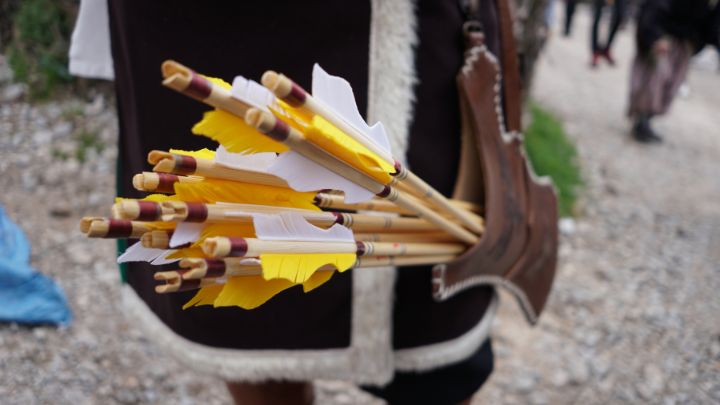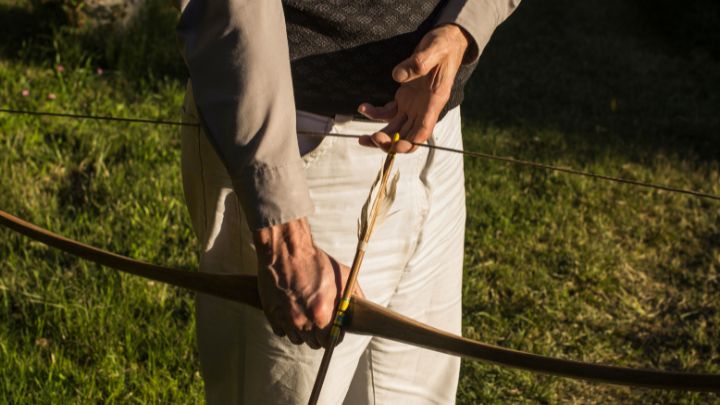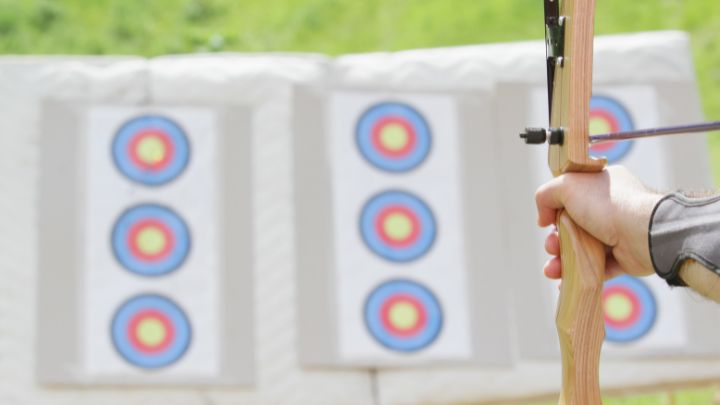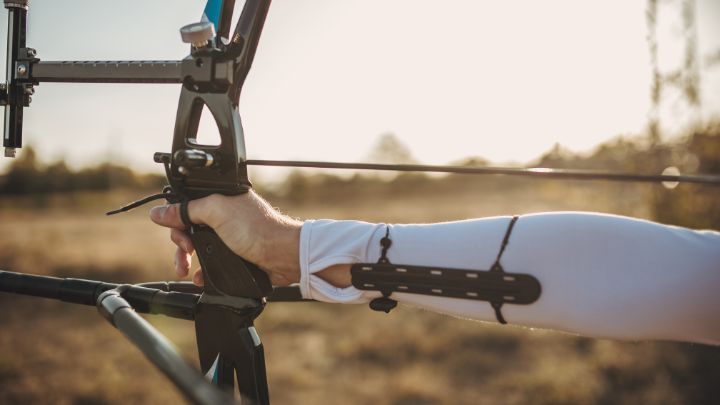Throughout my years as a coach, I’ve witnessed the transformative journey of countless students as they evolve from novices grasping their first bow to skilled archers who command the range with confidence.
Holding a bow and arrow is more than a mere action; it’s the initiation into an ancient discipline, a blend of art, sport, and science that has captivated humans for millennia. The grip of your hand, the stance you take, the pull of the string—these are the fundamental elements that forge a successful archer.
In this guide, we will walk the path of mastering these elements, dissecting each motion and moment to ensure your foundation is as solid as the bows crafted by the masters of the old.
The Fundamentals of Grip and Stance

Before you can send an arrow soaring toward its target, you must start with the foundational aspects of grip and stance. These elements set the stage for your success as an archer.
The Bow Grip
- The Foundation of Your Shot: The way you grip your bow can make or break your shot. A solid yet relaxed hold stabilizes your bow and aids in accuracy.
- Creating the Perfect Bow Grip: Your hand should rest comfortably on the grip, with your knuckles at a 45-degree angle to the bow. Your grip should be firm but not tight, preventing any unnecessary tension.
- Consistency is Key: Each time you hold your bow, strive for consistency. The same position every time leads to better muscle memory and improved accuracy.
The Archer’s Stance
- Balanced and Ready: A good stance is balanced and comfortable. Your feet should be shoulder-width apart, parallel to the shooting line, creating a stable base.
- Body Alignment: Your body should be perpendicular to the target, with hips and shoulders aligned. This position helps with both balance and aim.
The Draw Hand Position
- Contact Points: Your draw hand, the one pulling the string, should contact the string at the same points every time. This usually involves the tips of the first three fingers.
- The Hook and Hold: Rather than gripping the string, you “hook” it, letting it rest comfortably in the finger grooves.
- Relaxed but Controlled: Maintain a relaxed hand, with just enough tension to control the string.
Mastering the Art of the Draw

Drawing the bow is where the energy is built up to propel the arrow forward. It requires strength but also technique and finesse.
Establishing Your Anchor Point
- What’s an Anchor Point?: An anchor point is the position on your face where you consistently draw the string back to. It could be the corner of your mouth or your cheekbone, for example.
- Importance of Consistency: The same anchor point for every shot is crucial for consistent accuracy. Muscle memory will aid in finding this point naturally over time.
The Mechanics of a Smooth Draw
- The Draw Sequence: Begin with your arms at shoulder height and the bow pointing towards the target. Pull the string back in a smooth motion, keeping your elbow high.
- Engage the Right Muscles: Use your back muscles, not just your arms, to draw the string. This provides more power and reduces fatigue.
The Role of the Bow Arm
- Steady as She Goes: Your bow arm, the one holding the bow, needs to be steady and strong.
- Straight but Not Rigid: Keep your arm straight but not locked at the elbow to absorb the bow’s vibration.
- Alignment Matters: Your bow arm should be in line with the arrow for the most straightforward path toward the target.
The Technique of Aiming and Release

Aiming and releasing are the final, critical steps in shooting an arrow. It’s where all your preparation comes to fruition.
Aiming with Precision
- Sight or Instinct: Whether using a sight on your bow or shooting instinctively, your focus should be sharp.
- Consistent Eye Placement: Keep your dominant eye aligned with your aim. A consistent anchor point assists with this.
- The Concentration Factor: Aim with both your eye and your mind. Your full concentration should be on the target.
The Release – Making it Count
- The Fluid Release: A good release is like letting a breath out — smooth and unforced.
- Finger Movement: Let the string roll off your fingers. Don’t pluck it; that can disrupt the arrow’s flight.
- Follow Through: Continue to aim even after the arrow has left the bow. Your position should remain static until the arrow hits the target.
Essential Equipment Care and Maintenance

Maintaining your equipment is critical for peak performance in archery. A well-cared-for bow and set of arrows can be the difference between a miss and a bullseye.
Bow Maintenance Basics
- Regular Inspections: Check your bow regularly for signs of wear and tear, such as cracks or splintering.
- String Care: Wax the string to preserve its life and maintain its strength.
- Storage Solutions: Store your bow horizontally to avoid warping and in a cool, dry place.
Arrow Care Tips
- Shaft Inspection: Regularly check the straightness of your arrow shafts and look for any damage.
- Fletching and Nock Check: Ensure the fletchings are intact and the nock is not cracked.
- Proper Storage: Store arrows in a quiver or an arrow tube to prevent them from bending or getting damaged.
The Role of Accessories
- Arm Guards and Gloves: Protect yourself with an arm guard and use shooting gloves or a finger tab to save your fingers from blisters.
- Sight and Stabilizers: If you use them, ensure they are correctly adjusted and securely fastened.
- The Right Tools: Have the right tools on hand for any adjustments or repairs to your equipment.
Practice Makes Perfect – Training Tips
Regular practice is essential for honing your skills. But practice isn’t just about repetition; it’s about focused improvement.
Setting Goals and Sticking to Them
- Short and Long-Term Goals: Set achievable goals for each practice session and broader goals for your archery development.
- Track Your Progress: Keeping a record of your scores and performance can motivate you and show you where you need to focus your efforts.
Effective Practice Routines
- Quality over Quantity: It’s better to shoot a few arrows with excellent form than many with poor form.
- Varied Distances: Practice at different ranges to improve your adaptability and skill.
- Mental Rehearsal: Visualizing your shots can be as effective as physical practice.
Analyzing Your Technique
- Self-Review and Feedback: Review your form and technique, or get feedback from a coach or experienced archer.
- Use Technology: A slow-motion video can be a valuable tool for analyzing your technique.
- Stay Open to Learning: Always be willing to refine your technique and try new methods to improve.
Striving for Archery Excellence
Mastering archery doesn’t happen overnight. It takes patience, persistence, and a passion for the sport. Here’s how to refine your skills and pursue excellence in archery.
Developing Consistent Shooting Routines

Developing a consistent shooting routine is essential for building confidence and skill in archery.
The Power of Routine
- Building Muscle Memory: Through repetition, your body learns the movements, making them automatic.
- Creating a Pre-Shot Process: A pre-shot routine settles your nerves and prepares your body and mind for the shot.
Adjusting for Various Conditions
- Indoor vs. Outdoor: Practice in different environments. Outdoor conditions can include wind and weather variations, while indoor shooting focuses on precision in a controlled setting.
- Lighting Variations: Lighting can affect visibility and depth perception; practice in varying light to adapt your aiming.
Expanding Your Archery Knowledge

An archer’s education never ends. Learning more about the history, equipment, and techniques of archery can deepen your appreciation and skill in the sport.
Understanding the Mechanics of Archery
- Study the Physics: Understanding the forces at work when an arrow is shot can inform your technique and equipment choices.
- Equipment Knowledge: Learn about different types of bows and arrows and how they affect your shooting.
Learning from the Pros
- Watch Competitions: Observe professional archers. Notice their form, technique, and composure.
- Take Lessons: If possible, work with a coach to get professional insights into your form and technique.
Joining the Archery Community

Joining an archery club or community can provide support, friendship, and competition.
The Benefits of Community
- Shared Knowledge: Archery communities are a wealth of knowledge, with experienced archers often willing to share tips and advice.
- Competitive Opportunities: Clubs often host or participate in competitions, giving you a chance to test your skills.
Supporting Others
- Mentoring New Archers: Sharing what you’ve learned with new archers can be incredibly rewarding.
- Volunteering: Help out with club events or youth programs to give back to the archery community.
Embracing a Holistic Archery Lifestyle
Archery isn’t just a skill—it’s a lifestyle. Embrace it holistically to see improvements in all aspects of the sport.
Physical Fitness
- Core Strength: A strong core improves stability and shooting posture.
- Flexibility: Flexibility, particularly in the shoulders and back, can enhance your draw and prevent injuries.
Mental Focus
- Meditation and Visualization: These techniques can improve concentration and calmness, both essential for archery.
- Stress Management: Learning to manage stress can help you maintain composure during competition or challenging shots.
Archery Safety First
Safety should always be your top priority in archery. A safe archer is a responsible and respected member of the archery community.
Following Range Rules
- Understand the Dos and Don’ts: Every range has specific rules designed to keep everyone safe. Learn and follow them.
- Communication: Clear communication with fellow archers can prevent accidents.
Personal Safety Measures
- Inspect Equipment: Before each shooting session, check your equipment for safety.
- Mindful Shooting: Always be aware of your surroundings and never point a bow and arrow in an unsafe direction.
Upgrading Your Equipment
As your skills improve, you might find that your equipment needs to upgrade to keep pace with your advancement.
Choosing the Right Equipment
- Research: Do your homework before purchasing new equipment. Reviews and recommendations can guide your choices.
- Try Before You Buy: Whenever possible, test new equipment to see if it suits your style and improves your performance.
Investing in Quality
- Quality Over Quantity: It’s better to have a few pieces of high-quality equipment than many lower-quality items.
- Maintenance Over Time: Good equipment will last a long time if maintained properly, so invest time into taking care of your gear.
FAQs
Is there a specific type of bow that’s best for beginners to learn with?
Yes, many coaches recommend a recurve bow for beginners. It’s the type used in Olympic events and offers a good balance between simplicity and the ability to progress in skill.
The recurve bow’s design helps guide the arrow more efficiently, and the equipment is generally more accessible and user-friendly for those just starting out.
How often should I practice archery to improve my skills?
The frequency of practice can vary depending on your goals and schedule, but a good rule of thumb for beginners is to practice 2-3 times a week.
This allows you to build and maintain muscle memory and strength without overwhelming yourself. As you progress, you might increase the frequency and duration of your practice sessions.
Can practicing archery improve my physical health?
Absolutely! Archery can improve upper body strength, endurance, flexibility, and hand-eye coordination. Drawing a bow requires controlled use of your arm, chest, back, and shoulder muscles, while maintaining your stance engages your core muscles. Regular practice can contribute to overall physical fitness.
How can I ensure my arrows last as long as possible?
To extend the life of your arrows, always store them in a quiver or protective case to avoid damage. Use a soft, damp cloth to clean them after use and ensure they’re dry before storage.
Inspect them regularly for any signs of wear, and avoid shooting them into materials that could crack or bend them.
What’s the best way to deal with nerves while shooting?
Managing nerves is all about preparation and mindset. Develop a pre-shot routine that includes deep breathing to calm your heart rate and clear your mind.
Focus on the process of the shot, not the outcome. With experience, the nerves often transform into an asset, providing an adrenaline boost that can enhance focus and performance.
How do I know if I’m using the correct draw weight on my bow?
The correct draw weight should allow you to pull the bowstring back smoothly and hold it in the anchor position for at least 20 seconds without shaking or fatigue. If you find yourself struggling to maintain form or experiencing muscle fatigue quickly, the draw weight might be too high.
Conversely, if the draw feels effortless and doesn’t engage your back muscles adequately, it may be too low. It’s crucial to start with manageable draw weight and increase it gradually as you build strength and proficiency.
Final Words
Holding a bow and arrow is the beginning of a journey towards mastery in archery. The key is to build on the basics of grip, stance, draw, aim, and release. With dedication and practice, these fundamentals become second nature, allowing you to focus on the subtler aspects of the sport.
Remember, archery is as much about mental discipline as it is about physical skill. Stay patient, stay persistent, and most importantly, enjoy every shot you take.
I’m Matt, and I’ve been with GearDesciple for about five years after my brother Jared roped me in. I wasn’t always into the outdoors, but a few reluctant hikes turned into a real passion. Now, I help test and review gear with a focus on honest, experience-based advice. As someone who came to outdoor life later on, I’m especially driven to help newcomers find their footing.